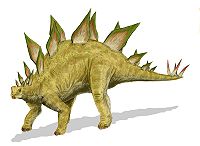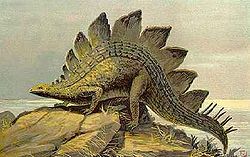- Stegosauridae
-
Stegosauridae
Temporal range: Middle Jurassic - Early Cretaceous, 170–100 Ma
Life restoration of Stegosaurus stenops Scientific classification 
Kingdom: Animalia Phylum: Chordata Class: Reptilia Superorder: Dinosauria Order: †Ornithischia Suborder: †Stegosauria Superfamily: †Stegosauroidea Family: †Stegosauridae
Marsh, 1880Type species †Stegosaurus stenops
Marsh, 1877Subgroups Stegosauridae is a family of stegosauria, large thyreophorans. They lived longer than other Stegosaurs; while all Huayangosauridae and most of basal stegosaurs died out in Tithonian - Kimmeridgian, stegosauridae survived till Middle Cretaceous. They are usually characterized by triangular plates on their back. These plates were not as hard as the plates of Huayangosauridae, so perhaps they were used only for display.[1]
However there are several exemptions:Dacentrurus,[2] Lexovisaurus and Kentrosaurus have also spikes on their back.
Contents
Distribution of Stegosauridae through time

Paleobiology
Evolution
In the family tree of Thyreophora, Stegosauridae are right in the middle. Some paleontologists, propose a theory that they evolved from dinosaurs like Scelidosaurus.[3] They state that in early stegosaurs, like Huayangosaurus, plates are relatively small, while in Stegosaurus, the most advanced member of the family, they are very large. Perhaps bony plates of stegosaurs evolved from scutes of Scelidosaurus[4] or its relatives.
Family tree of Thyreophora
Scelidosaurus, etc.↓ *↓
Lexovisaurus and other primitive stegosaurs↓ *Ankylosauria
Stegosaurinae
General anatomy
Stegosaurids were usually large and powerful dinosaurs. Their front legs were shorter than their rear making them slow - moving dinosaurs. When Othniel Charles Marsh first found Stegosaurus, he portrayed him with very short front legs and neck. But new evidence says that they had relatively long these body parts.[3] New discoveries suggest that in them was present sexual dimorphism.[5]
Bite
In 2010 Miriam Reichel from Switzerland[6] using software "ZBrush" created two Stegosaurus teeth digital models: one was serrated, and another lacked serrations. He proved that Stegosaurus had rhamphotheca. Also he found that stegosaurs was capable of bitng small branches.
He also suggested that the same data could be applied to other Stegosauridae.
Classification
Taxonomy
Stegosaurids are usually divided into two main subfamilies: Dacentrurinae and Stegosaurinae.[7] Stegosaurinae are usually characterized by large sizes. The earliest stegosaur is thought to be Lexovisaurus[8] from Bathonian of England. There was found a massive femur of the juvenile Lexovisaurus.
This is a list of stegosaurian genera by classification and location:
Suborder Thyreophora
Infraorder Stegosauria
- Family Stegosauridae
- Lexovisaurus (=Loricatosaurus)[9] — (United Kingdom & France)
- Kentrosaurus — (Tanzania, Africa)
- Paranthodon — (South Africa)
- Monkonosaurus — (Tibet, China)
- Tuojiangosaurus — (Sichuan, China)
- Subfamily Dacentrurinae[7]
- Dacentrurus — (United Kingdom, France & Spain)
- Miragaia — (Portugal)[10]
- Subfamily Stegosaurinae
- Stegosaurus — (Wyoming, USA)
- Hesperosaurus — (Wyoming, USA)
- Wuerhosaurus — (Xinjiang, Western China)
Phylogeny
A cladogramm by Kenneth Carpenter.[11]
Stegosauridae └──┬─?Chungkingosaurus └──┬──Chialingosaurus └──┬──┬──Wuerhosaurus │ └──┬──Dacentrurus │ └──Hesperosaurus └──┬──Tuojiangosaurus └──┬──┬──Kentrosaurus │ └──Lexovisaurus[12] └──┬──Stegosaurus stenops └──S. ungulatus (=?S. armatus)
He states, that Wuerhosaurus and Hesperosaurus are more closely related to Tuojiangosaurus and Dacentrurus, than to Stegosaurus. However, Thomas Holtz thinks that Hypsirophus, Stegosaurus, Hesperosaurus and Wuerhosaurus form a subfamily-Stegosaurinae.[7]
Cladogramm by Holtz et al.
Stegosauridae └──┬──┬──Dacentrurinae │ └──┬──Dacentrurus │ └──Miragaia └──┬──Stegosaurinae └──┬──┬──Wuerhosaurus │ └──Hesperosaurus └──┬──Stegosaurus └──Hypsirophus
Primitive Stegosauridae
Most of primitive stegosaurids, such as Lexovisaurus, Kentrosaurus, and Tuojiangosaurus, arecharacterized by triangular plates running along their ba and reduced lateral osteoderms.[13] Some of them like Kentrosaurus, also had spines on second half of their back and postorbital horns.[14]
Dacentrurinae
Today are known only 2 members of Dacentrurinae: Dacentrurus and Miragaia.[15] They usually have long back spines and necks.
References
- ^ "Stegosaur plates used for identification". National Geographic website. National Geographic News. 25 May 2005. http://news.nationalgeographic.com/news/2005/05/0525_050525_stegosaur.html. Retrieved 2006-10-26.
- ^ M.L. Casanovas Cladellas. Dacentrurus armatus (Stegosauria, Dinosauria) del Cretácico inferior de los Serranos (Valencia, España).
- ^ a b James O. Farlow,M. K. Brett-Surman. The Complete Dinosaur. http://www.google.com/books?hl=ru&lr=&id=FOViD-lDPy0C&oi=fnd&pg=PA291&dq=Paleobiology+of+Stegosauridae&ots=N9DElkklTe&sig=3pJh_INQc8eKHNNjjaqyG9NX5AE#v=onepage&q=Paleobiology%20of%20Stegosauridae&f=false.
- ^ Norman, David (2001). "Scelidosaurus, the earliest complete dinosaur" in The Armored Dinosaurs, pp 3-24. Bloomington: Indiana University Press. ISBN 0253339642.
- ^ Holly E. Bardenab & Susannah C. R. Maidmentc. Evidence for sexual dimorphism in the stegosaurian dinosaur Kentrosaurus aethiopicus from the Upper Jurassic of Tanzania. http://www.tandfonline.com/doi/abs/10.1080/02724634.2011.557112.
- ^ Miriam Reichel (2010). "A model for the bite mechanics in the herbivorous dinosaur Stegosaurus (Ornithischia, Stegosauridae)". http://www.springerlink.com/content/j846p31k68w06w8p/.
- ^ a b c Thomas R. Holtz, Jr. (2007). Dinosaurs: The Most Complete, Up-to-Date Encyclopedia for Dinosaur Lovers of All Ages. Random House. http://www.geol.umd.edu/~tholtz/dinoappendix/HoltzappendixWinter2010.pdf.
- ^ Peter M. Galton and H. Philip Powell. "Stegosaurian Dinosaurs from the Bathonian(Middle Jurassic) of England, the earliest record of the family Stegosauridae".
- ^ Maidment, Susannah C.R.; Norman, David B.; Barrett, Paul M.; and Upchurch, Paul (in press). "Systematics and phylogeny of Stegosauria (Dinosauria: Ornithischia)". Journal of Systematic Palaeontology 6 (04): 367. doi:10.1017/S1477201908002459.
- ^ Mateus, Octávio; Maidment, Susannah C.R.; and Christiansen, Nicolai A. (2009). "A new long-necked 'sauropod-mimic' stegosaur and the evolution of the plated dinosaurs" (pdf). Proceedings of the Royal Society B: Biological Sciences online (1663): 1815–21. doi:10.1098/rspb.2008.1909. PMC 2674496. PMID 19324778. http://rspb.royalsocietypublishing.org/content/early/2009/02/21/rspb.2008.1909.full.pdf+html.
- ^ Carpenter, K., Miles, C.A., and Cloward, K. (2001). "New Primitive Stegosaur from the Morrison Formation, Wyoming", in Carpenter, Kenneth(ed) The Armored Dinosaurs. Indiana University Press. ISBN 0-253-33964-2, 55–75.
- ^ P.M. Galton. British plated dinosaurs (Ornithischia, Stegosauridae).
- ^ P.C.Sereno. The evolution of dinosaurs.
- ^ P.C.Sereno. The skull of the basal stegosaur Huayangosaurus taibaii and a cladistic diagnosis of Stegosauria.
- ^ J.I.Ruiz-omeñaca. "New stegosaurian (Ornithischia, Thyreophora) remains from Jurassic-Cretaceous transition beds of Valencia province (Southwestern Iberian Range, Spain)".
Categories:- Thyreophorans
- Stegosaurs
- Family Stegosauridae
Wikimedia Foundation. 2010.

